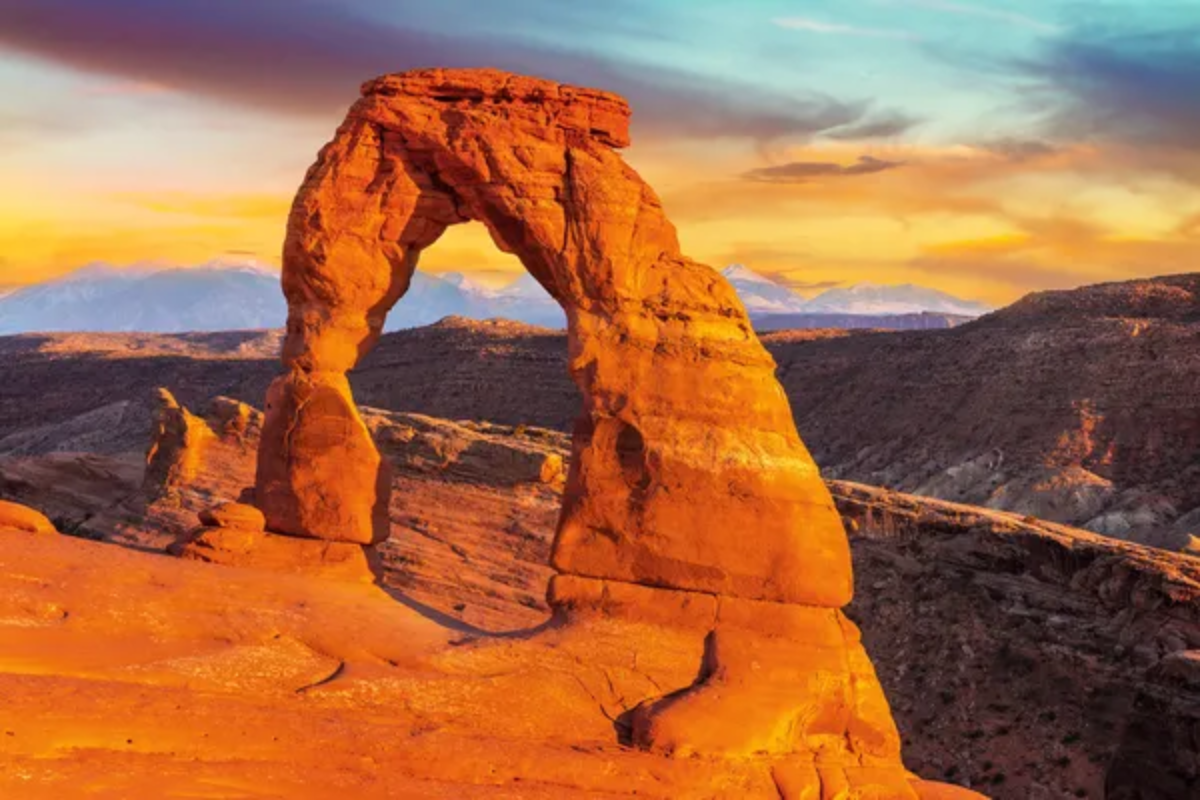America’s national parks preserve some of the most spectacular landscapes on Earth—places where nature’s artistry creates scenes so breathtaking they almost appear unreal. From towering granite monoliths to rainbow-hued thermal features, these protected areas offer photographers endless opportunities to capture images that inspire awe and wanderlust.
While photographs can never fully convey the experience of standing in these magnificent places, they serve as powerful invitations to explore these natural treasures firsthand and connect with something larger than ourselves. The desire to document and share these extraordinary landscapes has existed since long before social media, but platforms like Instagram have certainly amplified our awareness of iconic viewpoints.
Here is a list of 16 locations within the National Park System that consistently captivate viewers with their photogenic qualities and distinctive natural features.
Tunnel View, Yosemite National Park

Perhaps the most classic national park vista of all, this sweeping panorama showcases Yosemite Valley’s greatest hits in one frame: El Capitan rising on the left, Bridalveil Fall cascading on the right, and Half Dome commanding attention in the distance. The view reveals itself suddenly as you emerge from a mountain tunnel, creating a dramatic unveiling effect that has stopped travelers in their tracks since the road opened in 1933.
Morning light illuminates the entire valley, while late afternoon creates dramatic shadows on the massive granite formations. Winter storms occasionally dust the scene with snow, transforming the familiar view into something even more magical.
Delicate Arch, Arches National Park

Standing alone on the edge of a natural sandstone bowl, this 65-foot freestanding arch has become the unofficial symbol of Utah. The moderately challenging 1.5-mile trail to reach it ensures that your photograph represents both natural beauty and personal achievement.
Sunset brings warm light that makes the red sandstone glow with otherworldly intensity, while the La Sal Mountains provide a snow-capped backdrop against the desert foreground. Photographers arriving before dawn are rewarded with the arch silhouetted against brightening skies and far fewer fellow visitors sharing the limited viewpoints around this fragile formation.
Like Travel Pug’s content? Follow us on MSN.
Grand Prismatic Spring, Yellowstone National Park

This enormous hot spring—larger than a football field—creates a rainbow-colored spectacle unlike anything else on Earth, with concentric rings of vibrant orange, yellow, and green surrounding a deep blue center. The newly constructed overlook trail offers elevated perspectives that fully reveal the spring’s chromatic glory and massive scale.
Steam rising from the 160-degree water creates an ethereal effect, especially on cool mornings when the mist catches golden sunlight. Summer brings the most intense colors as sun-loving microorganisms reach peak vibrancy in the warm months, making mid-day visits between June and August ideal for capturing the most striking hues.
Thor’s Well, Oregon Coast (Cape Perpetua Scenic Area)

This seemingly bottomless sink in the volcanic shoreline appears to drain the Pacific Ocean with each incoming wave—creating dramatic photo opportunities at high tide or during winter storms. Located within the Cape Perpetua Scenic Area administered by the National Forest Service, this natural feature sits along the rugged Oregon coast where waves crash into a collapsed sea cave, shooting water skyward before it drains back into the opening.
Sunset brings dramatic backlighting to the spray, creating golden highlights against the dark basalt shoreline. Photographers should exercise extreme caution when visiting, as unexpected waves can sweep across the slippery rocks without warning.
ngels Landing, Zion National Park

The vertiginous final half-mile of this famous trail—with 1,000-foot drop-offs on both sides and only chain handrails for security—leads to a summit offering unmatched views down the length of Zion Canyon. The massive red and cream sandstone walls create a natural amphitheater that changes character throughout the day as shadows shift across their textured surfaces.
Morning light illuminates the eastern walls while late afternoon brings a warm glow to the western side, with the Virgin River appearing as a distant ribbon winding along the canyon floor 1,500 feet below. The challenging nature of the trail means photographs from this vantage point represent considerable personal accomplishment.
Like Travel Pug’s content? Follow us on MSN.
Cadillac Mountain Summit, Acadia National Park

As the highest point on the Eastern Seaboard, this rounded granite peak offers the first view of sunrise in the United States for part of the year. The 360-degree panorama encompasses island-dotted Atlantic waters, forested mountains, and the charming town of Bar Harbor nestled along the coast.
Autumn brings spectacular color to the deciduous forests below, creating a patchwork of red and gold against the blue water backdrop. Winter transforms the scene into a crystalline wonderland when ice storms coat the exposed summit rocks and stunted trees with a glittering layer—though access becomes more challenging in snowy conditions.
Horseshoe Bend, Glen Canyon National Recreation Area

The Colorado River makes a dramatic 270-degree turn around a massive sandstone escarpment, creating one of the most photographed landscapes in the Southwest. Standing at the overlook 1,000 feet above the river provides a dizzying perspective on this geological wonder, with the deep emerald water contrasting against the striated orange cliffs.
Early morning or late afternoon brings the best light when shadows add dimension to the canyon walls, though sunrise and sunset present challenges with extreme contrast between bright sky and shadowed canyon. A wide-angle lens proves essential to capture the entire bend in a single frame.
Balanced Rock, Garden of the Gods

This gravity-defying formation stands as the centerpiece of a National Natural Landmark adjacent to Colorado Springs, where massive red sandstone fins and balanced formations create an otherworldly landscape against the backdrop of snow-capped Pikes Peak. Sunrise bathes the rocks in warm golden light, while dramatic afternoon thunderstorms can create spectacular rainbows arching over the garden.
Winter occasionally brings snow that dramatically highlights the red rock formations against pristine white ground. The accessibility of paved trails throughout the park makes these spectacular formations available to photographers of all mobility levels.
Like Travel Pug’s content? Follow us on MSN.
Landscape Arch, Arches National Park

Stretching 306 feet from base to base, this improbably thin ribbon of sandstone stands as the longest natural arch in North America—and appears ready to collapse at any moment. The relatively easy 1.6-mile round-trip hike to view it ensures good photographs require minimal exertion, though the trail ends at a viewing area after rock falls made approaching the arch itself too dangerous.
Early morning light illuminates the underside of the arch, while late afternoon brings warm tones to the surrounding fins and formations. The knowledge that this delicate span could collapse without warning—as sections have done in recent decades—adds poignancy to images of this remarkable structure.
Zabriskie Point, Death Valley National Park

The first light of day transforms these barren badlands into a mesmerizing landscape of golden ridges and shadowy valleys—a photographer’s dream worth the pre-dawn alarm. The viewpoint overlooks a maze of eroded sedimentary formations whose mineral content creates bands of color ranging from gold to chocolate brown.
Without vegetation to obscure their forms, these undulating hills reveal geology in its purest expression. The iconic view toward Manly Beacon includes the salt flats of Death Valley in the distance with towering Telescope Peak on the horizon—especially dramatic on winter mornings when snow caps the distant mountains.
Logan Pass, Glacier National Park

The highest point on Glacier’s legendary Going-to-the-Sun Road delivers expansive alpine vistas where snow often lingers into July, and mountain goats pose obligingly against dramatic backdrops. Hidden Lake Overlook Trail leads from the visitor center to views of glacier-carved peaks reflected in an alpine lake, while wildflower displays peak in mid-summer when the meadows explode with color.
Due to heavy snowfall, this area typically remains accessible only from mid-July through September, creating a narrow window to capture these spectacular mountain scenes before winter reclaims the high country.
Like Travel Pug’s content? Follow us on MSN.
Mather Point, Grand Canyon National Park

The classic first view for most Grand Canyon visitors delivers an almost overwhelming panorama of colorful rock layers descending a mile to the Colorado River below. Located near the main visitor center on the South Rim, this accessible viewpoint offers unobstructed vistas extending 30+ miles on clear days.
Arriving for the first light allows photographers to capture the canyon emerging from shadow as sunlight gradually illuminates each successively deeper layer of ancient rock. Winter occasionally brings snow to dust the rim, creating extraordinary contrast against the reddish canyon walls, while summer monsoon storms can create dramatic light conditions and rainbows.
Lake McDonald, Glacier National Park

The crystal-clear waters of Glacier’s largest lake perfectly mirror the surrounding mountains, especially during calm mornings when the surface becomes glass-like. Colorful stones line the shoreline near Apgar Village, creating natural foreground elements for classic compositions featuring distant peaks.
Wildfire smoke sometimes creates eerily beautiful sunset conditions, with the sun appearing as a vivid red ball through the haze. Winter brings peaceful solitude when snow blankets the surrounding mountains, and ice sometimes forms along the lakeshore, though road access becomes more limited during the snowy season.
Mesa Arch, Canyonlands National Park

For a brief period each clear morning, sunlight streams through this cliff-edge arch and illuminates its underside with an otherworldly orange glow that seems artificially lit. The arch frames a spectacular view of the canyon landscape beyond, creating a natural window that perfectly composes the distant formations.
This phenomenon has become so popular that photographers often arrive hours before dawn to secure tripod positions—a testament to the magical quality of this fleeting light show. The relatively short half-mile round-trip hike makes this spot accessible to most visitors willing to navigate by headlamp in pre-dawn darkness.
Like Travel Pug’s content? Follow us on MSN.
Schwabacher Landing, Grand Teton National Park

The Snake River creates a perfect mirror for the jagged Teton Range at this peaceful riverside location, especially during calm mornings when beaver ponds reflect the mountains in exquisite detail. Wildlife, including moose, elk, and waterfowl, often make surprise appearances, adding living elements to already spectacular landscape compositions.
Autumn brings golden aspens that complement the coniferous forests along the slopes, while spring features wildflowers along the riverbank. The best photographs often come just before official sunrise when Alpenglow paints the mountain peaks with pink light while the foreground remains in shadow.
Hoh Rain Forest, Olympic National Park

Ancient moss-draped maples create an enchanted forest atmosphere unlike anywhere else in America, with misty conditions adding mood to photographs of this temperate rainforest receiving up to 14 feet of annual precipitation. The Hall of Mosses Trail offers accessible immersion into this primeval landscape where nearly every surface hosts growing things in countless shades of green.
Sunlight filtering through the canopy creates magical spotlighting effects, especially after rain when droplets glisten on every surface. Unlike many national park highlights, this location photographs beautifully on overcast days when soft light reveals subtle colors and textures without harsh shadows.
The Visual Legacy of America’s Protected Lands

These iconic locations represent just a fraction of the photographic possibilities within America’s expansive national park system—places that continue inspiring visual artists more than 150 years after the first photographs of Yellowstone helped convince Congress to establish the world’s first national park. While these destinations certainly deserve their popularity on social media, the most meaningful images often come from personal exploration beyond the famous viewpoints—discovering one’s connection to these extraordinary landscapes.
The true value of these photographs extends beyond their aesthetic appeal, serving as visual ambassadors that inspire the conservation of these irreplaceable natural treasures for future generations.
Like Travel Pug’s content? Follow us on MSN.
More from Travel Pug

- Cities Growing so Fast You Won’t Recognize Them in 10 Years
- 13 Destinations Where Tourists Regularly Regret Their Trip
- 16 U.S. Cities That Are Quietly Becoming Travel Hotspots
- Where to Travel If You Love Long Bus Rides and Daydreams
- 20 Cities Perfect for Solo Travelers Who Crave Adventure & Culture
Like Travel Pug’s content? Follow us on MSN.
